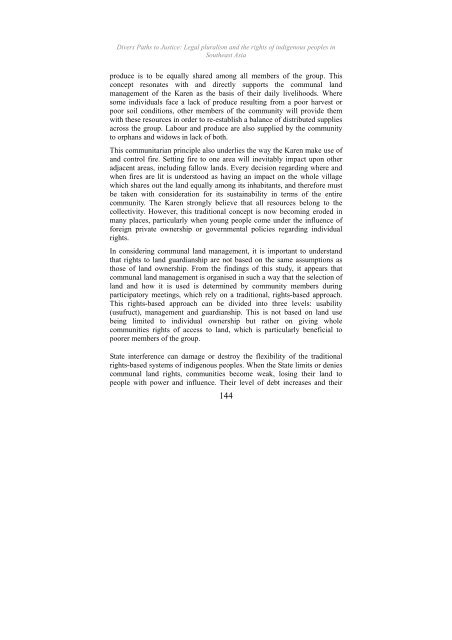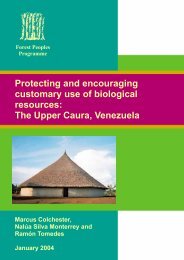Divers Paths to Justice - English - Forest Peoples Programme
Divers Paths to Justice - English - Forest Peoples Programme
Divers Paths to Justice - English - Forest Peoples Programme
You also want an ePaper? Increase the reach of your titles
YUMPU automatically turns print PDFs into web optimized ePapers that Google loves.
<strong>Divers</strong> <strong>Paths</strong> <strong>to</strong> <strong>Justice</strong>: Legal pluralism and the rights of indigenous peoples inSoutheast Asiaproduce is <strong>to</strong> be equally shared among all members of the group. Thisconcept resonates with and directly supports the communal landmanagement of the Karen as the basis of their daily livelihoods. Wheresome individuals face a lack of produce resulting from a poor harvest orpoor soil conditions, other members of the community will provide themwith these resources in order <strong>to</strong> re-establish a balance of distributed suppliesacross the group. Labour and produce are also supplied by the community<strong>to</strong> orphans and widows in lack of both.This communitarian principle also underlies the way the Karen make use ofand control fire. Setting fire <strong>to</strong> one area will inevitably impact upon otheradjacent areas, including fallow lands. Every decision regarding where andwhen fires are lit is unders<strong>to</strong>od as having an impact on the whole villagewhich shares out the land equally among its inhabitants, and therefore mustbe taken with consideration for its sustainability in terms of the entirecommunity. The Karen strongly believe that all resources belong <strong>to</strong> thecollectivity. However, this traditional concept is now becoming eroded inmany places, particularly when young people come under the influence offoreign private ownership or governmental policies regarding individualrights.In considering communal land management, it is important <strong>to</strong> understandthat rights <strong>to</strong> land guardianship are not based on the same assumptions asthose of land ownership. From the findings of this study, it appears thatcommunal land management is organised in such a way that the selection ofland and how it is used is determined by community members duringparticipa<strong>to</strong>ry meetings, which rely on a traditional, rights-based approach.This rights-based approach can be divided in<strong>to</strong> three levels: usability(usufruct), management and guardianship. This is not based on land usebeing limited <strong>to</strong> individual ownership but rather on giving wholecommunities rights of access <strong>to</strong> land, which is particularly beneficial <strong>to</strong>poorer members of the group.State interference can damage or destroy the flexibility of the traditionalrights-based systems of indigenous peoples. When the State limits or deniescommunal land rights, communities become weak, losing their land <strong>to</strong>people with power and influence. Their level of debt increases and their144
















